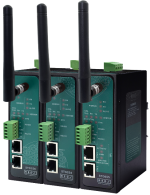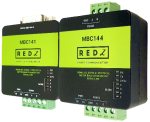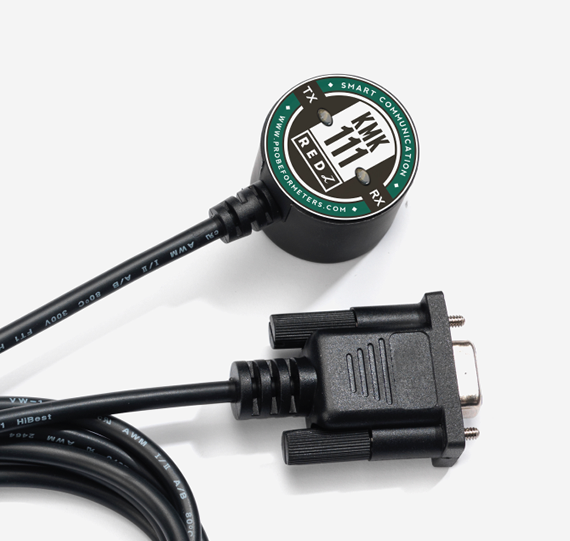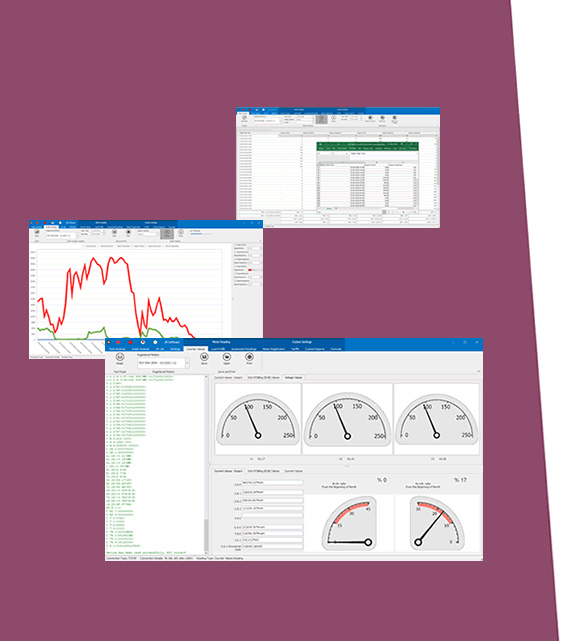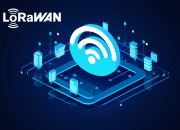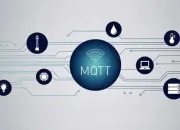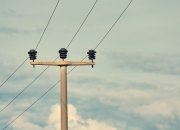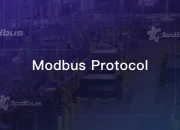1. Introduction
In today's rapidly digitizing world, IoT (Internet of Things) devices and applications are becoming increasingly prevalent. In this context, long-range wireless communication technologies play a significant role. One such technology that stands out is LoRa, which offers an innovative solution for low-power, long-range wireless communication. In this text, we will delve into what LoRa technology is, how it works, and explore its potential application areas.
2. Basic Principles of LoRa Technology
2.1 What is LoRa?
LoRa (Long Range) is a wireless communication technology specifically designed for long-range, low-power applications. Essentially, LoRa devices utilize radio frequencies for data transmission. However, unlike traditional wireless communication technologies, LoRa offers long-range transmission capabilities coupled with low power consumption.
LoRa's key features include:
Long Range: LoRa typically has a range of several kilometers in open areas, allowing reliable communication even with distant sensors or devices.
Low Power Consumption: LoRa is known for its low power consumption. This feature is ideal for battery-operated devices and significantly extends battery life.
Adaptive Data Rate (ADR): LoRa devices can automatically adjust the data rate based on environmental conditions and communication quality. This enhances energy efficiency while ensuring communication reliability.
These features make LoRa an ideal choice for various IoT projects. Additionally, with the development of the open-source LoRaWAN protocol, LoRa technology has become even more widespread.
2.2 What is LoRaWAN and How Does it Work?
LoRaWAN (Long Range Wide Area Network) is the network layer of LoRa technology, enabling LoRa devices to connect to the internet. LoRaWAN is an open standard that facilitates efficient management and communication of LoRa devices.
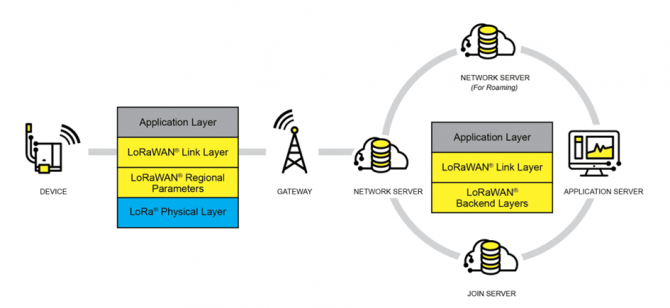
(Picture reference: https://lora-alliance.org/about-lorawan/)
The main components of LoRaWAN include:
Sensors and Devices: Low-power sensors and devices that connect to the LoRaWAN network.
LoRa Gateways: Gateways that receive data from LoRa devices and transmit it to the LoRaWAN network.
LoRaWAN Network Server: The central component of the LoRaWAN network, which manages and processes incoming data from gateways, and facilitates communication to the appropriate destination.
Application Server: Processes incoming data from LoRaWAN, analyzes it at the application level, and stores or presents it to the user.
LoRaWAN is based on the "Aloha" protocol and allows multiple nodes to transmit data in the same spectrum. Additionally, LoRaWAN provides secure communication through end-to-end encryption and security measures.
The working principles of LoRaWAN include:
Collection of Sensor Data: Data from LoRa devices is collected by nearby LoRa gateways.
Data Transmission via Gateways: Gateways transmit collected data to the LoRaWAN network using appropriate protocols.
Processing by Network Server and Application Server: The Network Server manages incoming data and facilitates communication to the appropriate Application Server for further processing.
Processing at Application Level: The Application Server processes incoming data at the application level, stores it, and presents it to the user as needed.
LoRaWAN provides a reliable, low-cost, and scalable network solution for IoT applications. With its features, LoRaWAN finds widespread use across various industries.
2.3 Modulation Technique: Chirp Spread Spectrum (CSS)
Chirp Spread Spectrum (CSS) is the fundamental modulation technique used in LoRa. This modulation technique enables LoRa to achieve its long-range and low-power consumption characteristics.
The basic principle of CSS involves modulating the carrier frequency with a linearly varying signal. Unlike traditional modulation techniques, where the carrier frequency is constant, in CSS, it changes over time, resulting in a 'spread' signal in the frequency domain.
The CSS modulation in LoRa provides the following advantages:
Resilience to Noise: Chirp Spread Spectrum is more resilient to noise, even in noisy environments, compared to narrowband modulations.
Long Range: The linear frequency change enables LoRa's long-range capability.
Low Power Consumption: CSS modulation is known for its low power consumption, enabling long battery life for LoRa devices.
CSS modulation in LoRa enables one of the key advantages of LoRa, its long-range communication and low power consumption. Additionally, it provides flexibility to developers, accommodating various application scenarios.
3. Advantages of LoRa
3.1 Long Range
LoRa technology offers a long-range communication capability, typically spanning several kilometers in open areas. This extended range allows LoRa devices to communicate reliably over long distances, making it suitable for applications such as remote monitoring, asset tracking, and smart city deployments.
3.2 Low Power Consumption
One of the key advantages of LoRa technology is its low power consumption. LoRa devices can operate on battery power for extended periods, making them ideal for use cases where continuous power supply may not be available or practical. This low power consumption also contributes to the overall energy efficiency of IoT deployments.
3.3 Wide Coverage Area
LoRa technology provides wide coverage area, allowing for seamless communication across large geographic areas. This wide coverage area is achieved through the use of LoRa gateways, which can receive signals from multiple LoRa devices and relay them to the LoRaWAN network. As a result, LoRa networks can cover entire cities or even rural areas with relatively few gateways.
3.4 Cost Effectiveness
LoRa technology is cost-effective compared to other wireless communication technologies, particularly in terms of infrastructure deployment and operating expenses. The long-range capability of LoRa reduces the number of gateways required to cover a given area, resulting in lower infrastructure costs. Additionally, the low power consumption of LoRa devices translates to longer battery life and lower maintenance costs.
4. Disadvantages of LoRa Technology
While LoRa technology offers numerous advantages, it also comes with some disadvantages. These disadvantages may include:
4.1 Limited Bandwidth
LoRa technology utilizes a limited bandwidth for data transmission. This can pose limitations, especially in applications requiring large-scale data transfer simultaneously. The bandwidth constraints of LoRa should be considered, particularly in applications requiring high-volume data transfer.
4.2 Low Data Transfer Rate
Despite its advantages of long range and low power consumption, LoRa technology is limited by its low data transfer rate. It may have lower data rates compared to other wireless communication technologies, which can impact performance in certain applications. This aspect should be taken into account, especially in applications requiring real-time data transmission.
4.3 Connection Stability
Despite the long-range advantage of LoRa technology, it may face some challenges in connection stability. Factors such as obstacles or congested network traffic can affect signal quality and connection reliability. This is particularly relevant when used in mobile devices or dynamic environments.
5. Applications of LoRa Technology
5.1 LoRa in Smart Cities
Smart city initiatives leverage LoRa technology for various applications aimed at improving urban infrastructure and services. Some common applications include:
Traffic Management and Parking: LoRa sensors can monitor traffic flow and parking space occupancy in real-time, allowing for optimized traffic routing and efficient parking management.
Environmental Monitoring: LoRa-enabled sensors can measure air quality, noise levels, and other environmental parameters, helping cities monitor pollution levels and take appropriate measures to improve environmental quality.
Smart Lighting: LoRa-based lighting systems revolutionize traditional lighting solutions by intelligently adjusting brightness levels based on ambient light conditions. These systems leverage LoRa-enabled sensors and controllers to dynamically regulate light output, ensuring optimal illumination while minimizing energy consumption. By responding to changes in natural light levels and occupancy patterns, LoRa-based smart lighting solutions enhance public safety and contribute to energy efficiency in various settings, from urban environments to commercial buildings and residential spaces.
Energy Management Solutions: LoRa technology facilitates efficient energy management solutions for optimizing energy distribution and consumption. LoRa-enabled energy management systems provide real-time monitoring and control capabilities, allowing organizations to track energy usage and implement strategies for cost savings and sustainability. By leveraging LoRa-based sensors and meters, these solutions offer granular insights into energy consumption patterns, enabling targeted measures to reduce waste and enhance efficiency. With LoRa technology, organizations can unlock the potential for smarter energy management practices that drive operational efficiency and environmental stewardship.
Fire Detection and Security Systems: LoRa sensors can detect fires, smoke, and other hazards in urban areas, enabling early detection and rapid response by emergency services. Furthermore, LoRa-based security systems provide surveillance and monitoring capabilities for public spaces, buildings, and critical infrastructure.
5.2 LoRa-Based Solutions in Agriculture and Farming
LoRa technology finds numerous applications in agriculture and farming, enabling farmers to monitor and manage their operations more effectively. Some key applications include:
Soil Moisture and pH Monitoring: LoRa sensors can measure soil moisture levels and pH levels, allowing farmers to optimize irrigation and fertilizer usage for improved crop yield and quality.
Weather Monitoring and Forecasting: LoRa-enabled weather stations collect data on temperature, humidity, rainfall, and wind speed, providing farmers with valuable insights for crop planning and risk management.
Livestock Tracking and Automatic Watering Systems: LoRa-based tracking devices help farmers monitor the location and health of livestock, while automated watering systems ensure animals have access to clean water at all times.
Equipment Monitoring and Management: LoRa sensors can track the location and usage of agricultural machinery, helping farmers optimize equipment deployment and maintenance schedules for increased efficiency and productivity.
5.3 Role of LoRa in Industrial IoT Applications
In industrial IoT (IIoT) applications, LoRa technology enables connectivity and data exchange across various industrial environments. Some common applications include:
Smart Warehouse Management: LoRa-based sensors monitor inventory levels, track asset location, and optimize warehouse operations, resulting in improved inventory accuracy and operational efficiency.
Machine Condition Monitoring: LoRa sensors collect data on machine performance and health parameters, enabling predictive maintenance strategies to minimize downtime and reduce maintenance costs.
Supply Chain Visibility: LoRa-enabled tracking devices provide real-time visibility into the movement and status of goods throughout the supply chain, enhancing transparency and enabling proactive decision-making.
Industrial Sensor Networks: LoRa networks support the deployment of large-scale sensor networks for monitoring environmental conditions, detecting anomalies, and ensuring regulatory compliance in industrial facilities.
5.4 LoRa Supported Smart Home Systems
In smart home systems, LoRa technology enables the creation of interconnected devices and services that enhance convenience, comfort, and security for homeowners. Some popular applications include:
Smart Energy Management: LoRa-enabled smart meters monitor energy consumption in real-time, allowing homeowners to track and optimize their energy usage for cost savings and environmental sustainability.
Home Security and Monitoring: LoRa-based security systems include door/window sensors, motion detectors, and surveillance cameras that provide real-time alerts and remote monitoring capabilities for enhanced home security.
Environmental Monitoring and Control: LoRa sensors measure indoor air quality, temperature, and humidity levels, enabling homeowners to maintain a comfortable and healthy living environment. Automated HVAC systems adjust heating and cooling settings based on occupancy and environmental conditions for energy efficiency.
Home Automation and Remote Control: LoRa-based smart home devices, such as lighting controls, smart locks, and irrigation systems, can be remotely controlled and automated to improve convenience and efficiency for homeowners.
6. The Future of LoRa
6.1 Evolving Standards and Technological Advancements
As the adoption of LoRa technology continues to grow, we can expect to see ongoing developments in LoRa standards and technological advancements. Some key areas of focus include:
Standardization Efforts: Organizations such as the LoRa Alliance are actively working to standardize LoRa technology and expand its capabilities to meet evolving industry requirements. Future releases of the LoRaWAN specification are expected to introduce new features and enhancements to further improve performance and interoperability.
Integration with Emerging Technologies: LoRa technology is increasingly being integrated with other emerging technologies such as artificial intelligence (AI), edge computing, and blockchain to enable new use cases and applications. These integrations enhance the intelligence, scalability, and security of LoRa-based solutions, opening up new opportunities for innovation.
Advancements in Hardware and Semiconductors: Ongoing advancements in hardware and semiconductor technology are driving improvements in LoRa device performance, power efficiency, and cost-effectiveness. New generations of LoRa chips and modules are expected to deliver higher data rates, longer battery life, and improved sensitivity, further expanding the capabilities of LoRa networks.
6.2 Growing Ecosystem and Industrial Collaborations
The LoRa ecosystem continues to expand rapidly, driven by growing demand for IoT solutions and industry-wide collaborations. Key trends shaping the future of the LoRa ecosystem include:
Diverse Application Verticals: LoRa technology is being deployed across a wide range of industries and application verticals, including smart cities, agriculture, industrial automation, and consumer electronics. This diversity of use cases is driving the development of specialized LoRa-based solutions tailored to specific industry needs.
Global Market Expansion: The adoption of LoRa technology is spreading beyond traditional markets, with growing interest and investment in regions such as Asia-Pacific, Latin America, and Africa. This global expansion is fueled by factors such as urbanization, industrialization, and government initiatives to promote digitalization and connectivity.
Collaborative Partnerships: Collaborative partnerships between technology providers, network operators, system integrators, and industry stakeholders are driving innovation and accelerating the deployment of LoRa-based solutions. These partnerships facilitate the development of end-to-end IoT solutions that address complex challenges and deliver tangible value to customers.
7. Conclusion
In conclusion, LoRa technology offers a powerful solution for long-range, low-power wireless communication in IoT applications. With its unique combination of long-range capability, low power consumption, wide coverage area, and cost-effectiveness, LoRa is well-suited for a wide range of use cases across various industries.
From smart cities and agriculture to industrial IoT and smart homes, LoRa technology is driving innovation and enabling transformative solutions that improve efficiency, enhance sustainability, and enhance quality of life. As the adoption of LoRa continues to grow and evolve, we can expect to see even greater advancements and applications in the future.
By leveraging the advantages of LoRa technology and embracing collaboration and innovation, organizations can unlock new opportunities and create value in the rapidly expanding IoT landscape.
This concludes our exploration of LoRa technology and its potential impact on the future of wireless communication. If you have any further questions or would like to delve deeper into any aspect of LoRa, please feel free to reach out.
REDZ Team



